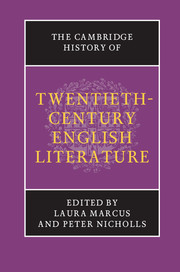Book contents
- Frontmatter
- Introduction
- PART ONE WRITING MODERNITY
- PART TWO THE EMERGING AVANT-GARDE
- PART THREE MODERNISM AND ITS AFTERMATH, 1918–1945
- 10 Trauma and war memory
- 11 The time–mind of the twenties
- 12 Modern life: fiction and satire
- 13 Modernist poetry and poetics
- 14 Modernity and myth
- 15 Psychoanalysis and literature
- 16 Biography and autobiography
- 17 ‘Speed, violence, women, America’: popular fictions
- 18 Theatre and drama between the wars
- 19 Literature and cinema
- 20 The thirties: politics, authority, perspective
- 21 Literary criticism and cultural politics
- 22 Surrealism in England
- 23 World War II: contested Europe
- 24 World War II: the city in ruins
- PART FOUR POST-WAR CULTURES, 1945–1970
- PART FIVE TOWARDS THE MILLENNIUM, 1970–2000
- Bibliography
- Index
- References
18 - Theatre and drama between the wars
from PART THREE - MODERNISM AND ITS AFTERMATH, 1918–1945
Published online by Cambridge University Press: 28 March 2008
- Frontmatter
- Introduction
- PART ONE WRITING MODERNITY
- PART TWO THE EMERGING AVANT-GARDE
- PART THREE MODERNISM AND ITS AFTERMATH, 1918–1945
- 10 Trauma and war memory
- 11 The time–mind of the twenties
- 12 Modern life: fiction and satire
- 13 Modernist poetry and poetics
- 14 Modernity and myth
- 15 Psychoanalysis and literature
- 16 Biography and autobiography
- 17 ‘Speed, violence, women, America’: popular fictions
- 18 Theatre and drama between the wars
- 19 Literature and cinema
- 20 The thirties: politics, authority, perspective
- 21 Literary criticism and cultural politics
- 22 Surrealism in England
- 23 World War II: contested Europe
- 24 World War II: the city in ruins
- PART FOUR POST-WAR CULTURES, 1945–1970
- PART FIVE TOWARDS THE MILLENNIUM, 1970–2000
- Bibliography
- Index
- References
Summary
Systems of periodisation promise a means of creating useful boundaries and categories of materials to be analysed, but they also contain inherent problems in relation to the processes of analysing those materials. This is especially the case with the period in question, traditionally seen by theatre historians as one in which mainstream drama did not generally reflect social change but, rather, pandered to middle-class tastes and sensibilities. The inter-war theatre industry was made up of a number of interdependent sectors, however, just as the middle classes themselves were widely defined and in a period of social transition. There were clear shifts and developments in the theatre industry and, as a consequence, in the kinds of plays being produced. However, these shifts and developments, although precipitated by it, had already been set in motion before World War I. The growth of the middle classes during the late nineteenth century, the increase in leisure time and the changed social attitudes to theatre and drama as a means of education and social cohesion are as influential upon the developments in British theatre and drama after World War I as are the extraordinary changes in the economic factors controlling the industry as a whole. The theatre of the period, ‘reflected many divergent trends and tendencies, and the impact of a number of individuals. It resists simplification.’ Many of the theatre critics of the period, highly idiosyncratic and class-conscious as much of their work is, clearly identify the economics of the theatre industry (rises in rent, the formation of management cartels) and a ‘new’ middle-class audience – often identified implicitly as lower-middle-class – as influencing the kinds of plays that the newly all-powerful managements were prepared to put on.
- Type
- Chapter
- Information
- The Cambridge History of Twentieth-Century English Literature , pp. 318 - 334Publisher: Cambridge University PressPrint publication year: 2005

